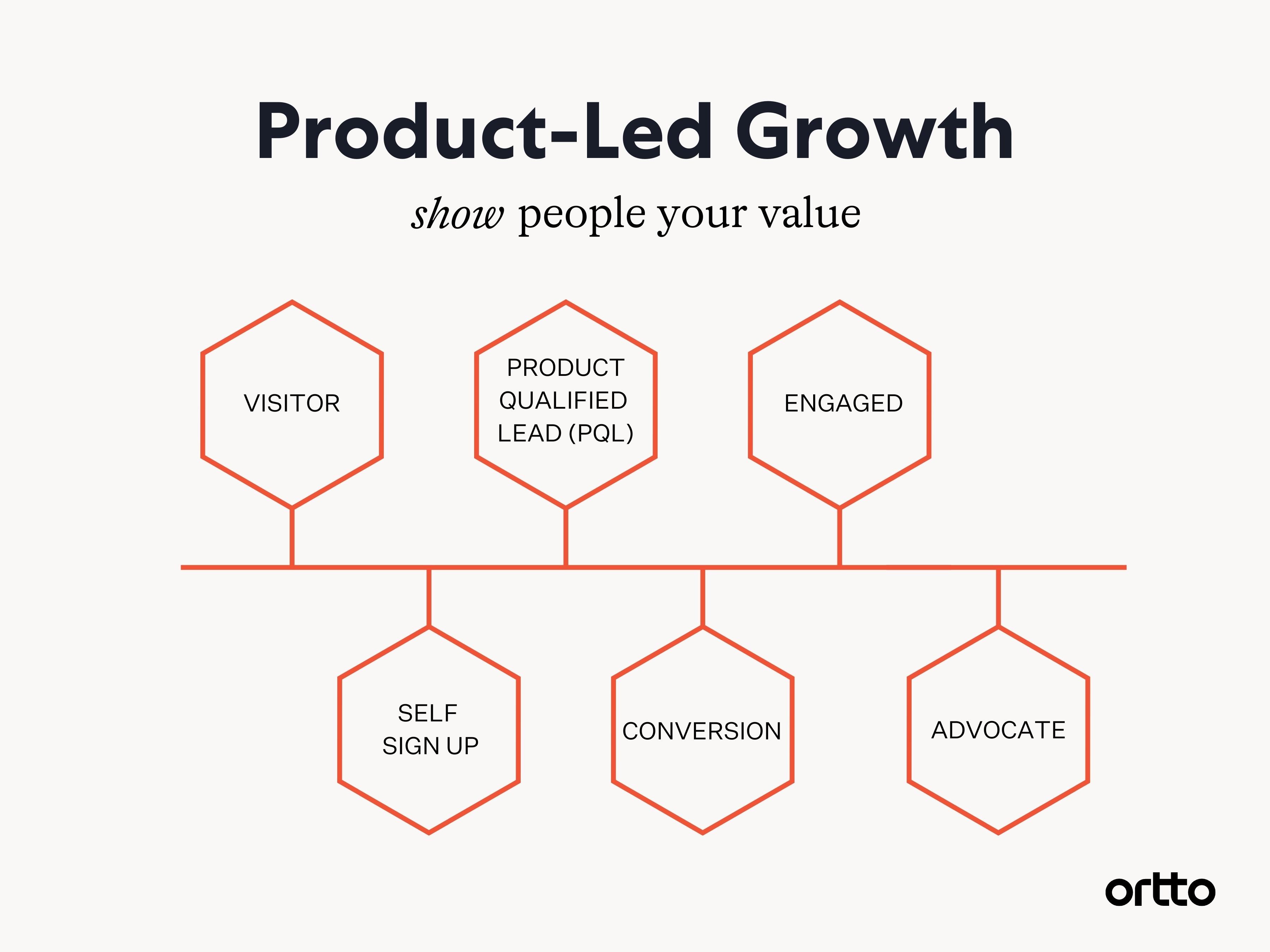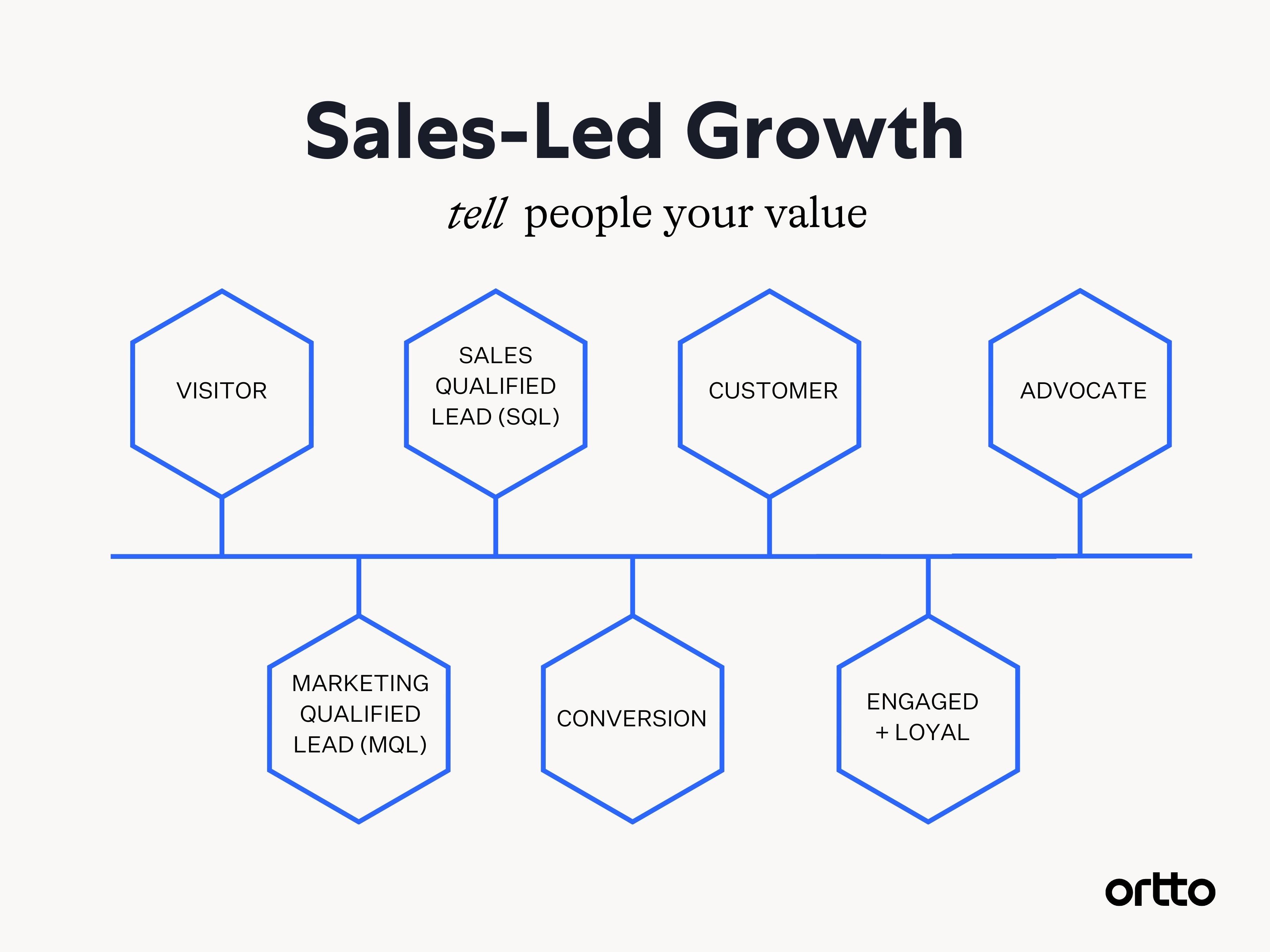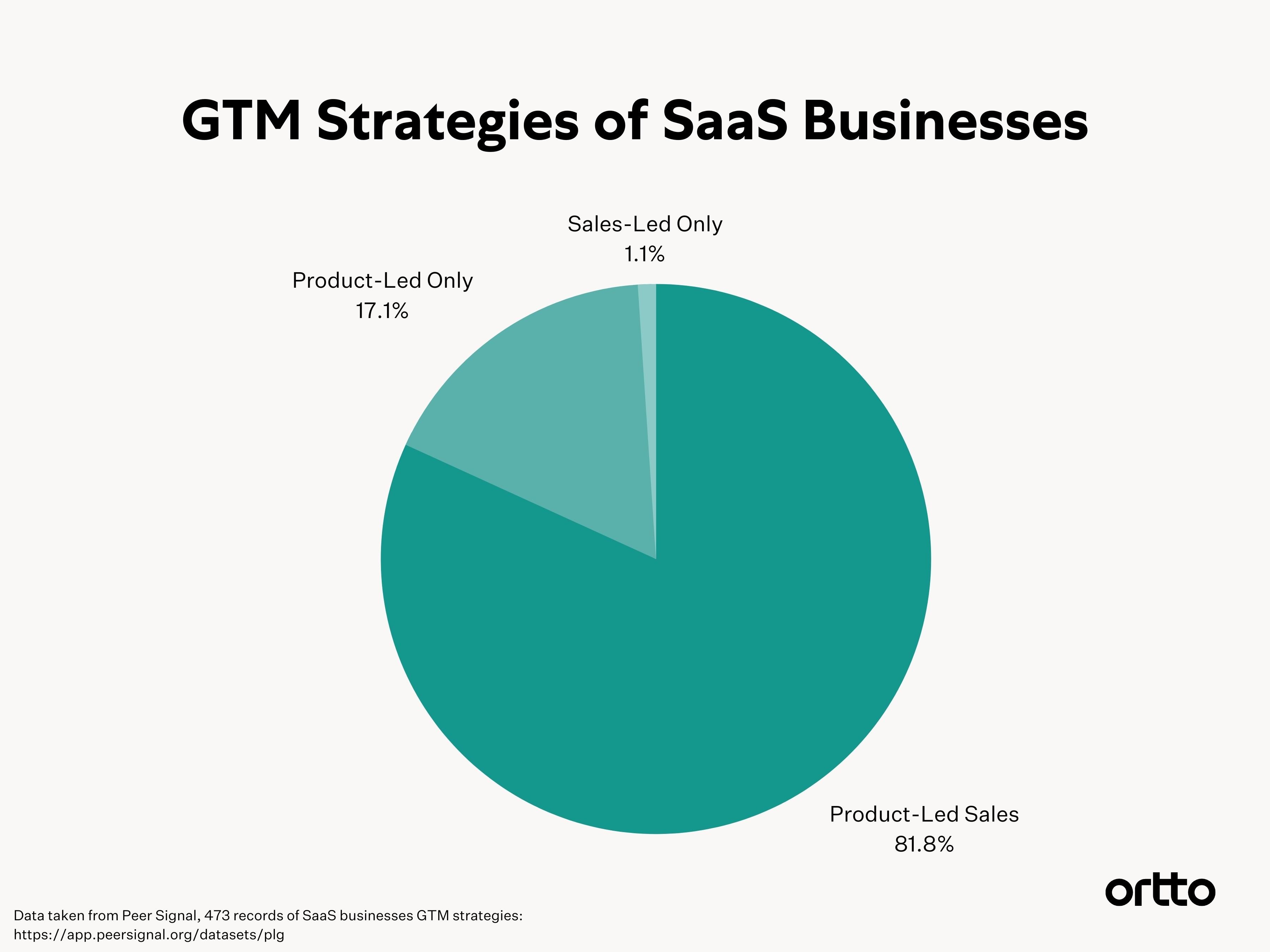Some of the most famous SaaS companies started their journey with zero sales representatives, relying entirely on a product-led, rather than a sales-led, strategy to increase their customer base and grow their revenue.
And, for a long time, this strategy was extremely successful, resulting in supercharged growth, a loyal base of customers and advocates, and a product that truly delivers a world-class experience.
Today, many of these companies have now added a sales team. This begs the question — in the product-led vs sales-led growth debate, which strategy really delivers the growth gains SaaS businesses are aiming for?
In this article, we'll explore:
What is product-led growth (PLG)?
In a product-led growth strategy, the product itself is the main vehicle for growth and retention, with every department in the business focused on creating a product that essentially sells itself. From a marketing perspective, this means optimizing campaigns, content and activities towards specific product actions that are proven to bring the customer closer to conversion. For success and support, it's about shepherding customers through the initial onboarding phase to help them realize value sooner. For product teas, updates, and new features will be prioritized according to what will improve the customer experience most.
A product-led growth strategy relies on the organization having either a free trial or freemium product available. Customers will sign up on their own and, guided by tools like a customer onboarding experience, knowledge base, automated marketing messages, chatbots, or a community of practice, will discover the value of your product in their organization and decide to become a paying customer.

What is sales-led growth?
A sales-led growth strategy relies on a sales team to go out and find leads, service product demo requests, and contract partners.

In between these two extremes is a different approach that is rapidly becoming the norm — product-led sales, a blended model that brings the best of both worlds into one powerful strategy for growth.
What is product-led sales?
Product-led sales is a model where sales and product are strategic growth partners. Essentially the company will have product-led growth strategies in place, like free trials or a freemium product, as well as sales team members who are primarily focused on enterprise-level plans and account-based marketing, but also might pitch in to help nudge smaller deals over the finish line.
One of the advantages of bringing these two strategies together is that sales teams have another means of qualifying and prioritizing leads. When inbound leads come in through the free trial, sales can use product usage data to determine their intent, identify what they need to do to reach that all-important 'aha moment', and personalize demos or communications to nudge them to conversion. These leads are referred to as product-qualified leads, and they can accelerate the funnel and reduce friction in the sales cycle.

Benefits of a product-led sales strategy
Put yourself in your buyer’s shoes and it quickly becomes clear how a show AND tell strategy like product-led sales can be beneficial. Customers get to explore your product first-hand, and sales calls or demos can focus on answering specific questions, showcasing advanced features or use cases, and negotiating terms.
This kind of customer-centricity has the following benefits for SaaS companies:
1. Lowering CAC
According to ProfitWell, CACs have increased by over 55% in the last five years. A product-led sales strategy reduces CACs by lowering the barrier to entry for customers and allowing sales teams to stay lean.
2. Higher LTV with revenue diversity
By implementing both product-led strategies and a sales team, your SaaS business will be better equipped to bring in those high LTV enterprise-level customers, while maintaining the revenue diversity that comes with a product-led model.
In a traditional sales-led operation, it was common for a small number of big customers to be the main drivers of your annual recurring revenue (ARR), which made losing just one of them incredibly risky. When sales teams are able to focus on these big fish while the product itself sells to the smaller fish, you’ll have a larger pool of customers and the idea of losing just one won’t keep you up at night.
3. Build a better product
When the product itself is doing the selling, every team is focused on improving the product, bringing different perspectives and solutions to ultimately build a product that is world-class. As SaaS explodes and competition grows fiercer by the minute, a great product that prioritizes shipping the features and updates that are most important to your customers is paramount to success.
4. Self-discovery sells
No one knows your customer’s business like they do, so even the best sales team could easily skip over a use case, feature, or benefit of the product that the customer sees instantly. This kind of self-discovery is powerful — when we feel as though we’ve reached our own ‘aha’ moment, we are more willing to buy in.
This reduces friction in the sales cycle, saves your team valuable time. Plus, it's a strategy that is more likely to create customers who are both loyalists and advocates.

Implementing a hybrid strategy
There are two ways to go here — add sales to a product-led organization or add elements of a product-led strategy to a sales-led organization. Both should be approached with care. Here are some tips for managing a hybrid-approach:
Adding sales to a product-led organization
Many of the most successful SaaS companies, like Slack, started with a product-led strategy and only added a sales function after they'd experienced significant business growth and product virality. Today, Slack (owned by Salesforce) continues to benefit from the virality of the product while growing from the enterprise-level deals sales teams bring in.
If you’re a product-led organization looking to add a sales function like Slack did, you will need to identify how the two strategies will co-exist. A lot of that comes down to identifying different lead types and sending them through the most appropriate sales path.
Here's how that could work:
1. Product-qualified leads (PQLs)
Product-qualified leads (PQLs) are low-hanging fruit for your sales team. They're the people who have signed up for a free trial or freemium plan, have taken product-qualifying actions, and have reached their 'aha' moment.
In some cases, these users will convert on their own, or with some assistance from your customer support team. In others, these users will be enterprise-level customers who need to work with sales to build custom pricing plans. There could also be a segment of PQLs who fall somewhere in between these two extremes — their free trial has come to an end or nearing limits in a freemium plan, and just need the sales team to nudge them along to conversion.
2. Marketing-qualified leads (MQLs)
Content initiatives, paid media, events, and other marketing activities are likely to generate leads who aren't ready to get in and sign up for a free trial. This could be because of time limitations, hesitation around sharing data or other information, or a reluctance to get started without a demo or more information. They also could be passive leads — in other words, those who have started exploring options like yours, but they're not quite ready to do the deep research required to make a decision.
In a hybrid strategy, setting up fit and intent scoring will help you determine which leads should be sent where. For example, the segment of MQLs with a low intent score could be sent to a nurture journey to ensure you are top of mind when they are ready to buy. The segment with a high fit and intent score could be directed straight to sales for outreach.
3. Outbound leads
As your team grows, you may want to identify or build a sub-team account-based marketing (ABM) professionals who can target specific, enterprise-level organizations. While ABM does take more time and resources, it can lead to bigger deals with a higher customer lifetime value — and these big fish can bolster your overall growth while the smaller fish are moving through a product-led or sales-supported road.
Even if ABM is not for your business, sales teams can identify and work outbound leads in the key verticals in your ICP. The materials created for your product-led strategy, like demo videos or interactive product experiences, can be incredibly helpful resources for these outbound emails or direct messages. Not only can they help increase response rate, they can help sales team members have more productive conversations with leads.
Integrating product-led strategies when you’re sales-led
This one is a little trickier to manage, but can be very worthwhile. As Alastair Simpson, Head of Strategy at Coassemble, shared in our SaaS Trends article, “By opening your product up to the market you can supercharge your acquisition funnel and see volumes of leads that a sales-led motion just can’t produce. By leveraging rich product data, sales organizations can prioritize who their sales representatives reach out to and when.”
If you’re in a similar position, start by following these three steps:
1. Consider pricing
Some more traditional sales-led companies do not reveal pricing until after initial product discovery calls and demonstrations take place, but product-led initiatives really do require some amount of pricing transparency. After all, if you’re jumping into an opt-out free trial, you’ll need to disclose the amount the customer will expect to pay before they’ll be willing to commit.
Consider how shifting to a product-led model will impact your tiered plans. If free trials or freemium plans are too much of a jump, look at how you could start with a product tour or pre-recorded demos that allow customers to see your product in action without the help of a sales person. This could be step one to unlocking a more product-led approach.
2. Unify your data
When operating in a product-led model, a single source of customer truth is essential. You will need to bring data from every department together alongside product data to see the customer journey in full, pinpoint the actions that make up a product-qualified lead, and help sales identify leads and approach conversations with full context.
Ortto has been designed to do just this — we use a collection of no-code integrations to unlock data from marketing, finance, support, sales, and product and collect it into a single customer profile. That way, you can discover the actions important to your business and get a complete view of the customer journey.
3. Make product part of everyone’s life
Product-led growth is a company-wide strategy. From marketing to customer service to sales, everyone needs to think about how the product can be improved to increase leads and MRR.
Marketing will focus on getting the product in the hands of the end-user and ensuring the experience of the product delivers on marketing messages. Sales will share intel with product teams, taking customer feedback on board to continually improve the product. Plus they’ll use new and improved features to reignite old leads and grow existing customers.
Like any strategy shift, there will likely be some road bumps along the way. But it will all be worth it in a year or two, when your product is selling itself, your CAC has reduced, your MRR has increased, your product is famous, and your sales team can focus on the big fish.
Product-led sales: The Goldilocks approach SaaS needed
Product-led sales is a hybrid strategy that can benefit the health of a business overall. It gives you more avenues for leads, helps you build a more sustainable business (i.e. you're not over-reliant on a small number of enterprise clients AND you don't need to bring in an unrealistic number of leads to reach your revenue goals), and it generally results in a better, more competitive product.



